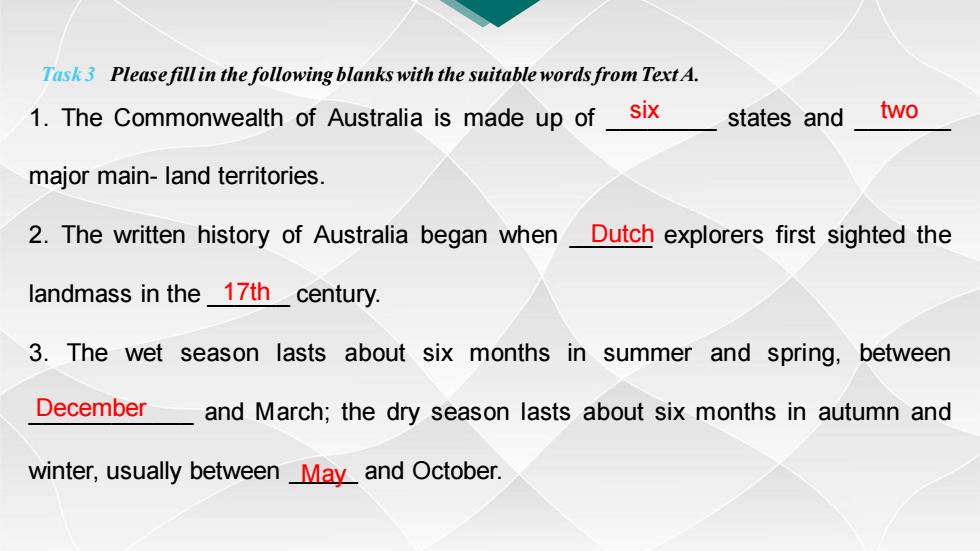
Task 3 Please fill in the following blanks with the suitable words from Text A. 1.The Commonwealth of Australia is made up of six states and two major main-land territories. 2.The written history of Australia began when Dutch explorers first sighted the landmass in the 17th century. 3.The wet season lasts about six months in summer and spring,between December and March;the dry season lasts about six months in autumn and winter,usually between May_and October
Task 3 Please fill in the following blanks with the suitable words from Text A. 1. The Commonwealth of Australia is made up of ________ states and _______ major main- land territories. 2. The written history of Australia began when ______ explorers first sighted the landmass in the ______ century. 3. The wet season lasts about six months in summer and spring, between ____________ and March; the dry season lasts about six months in autumn and winter, usually between _____ and October. six two Dutch 17th December May
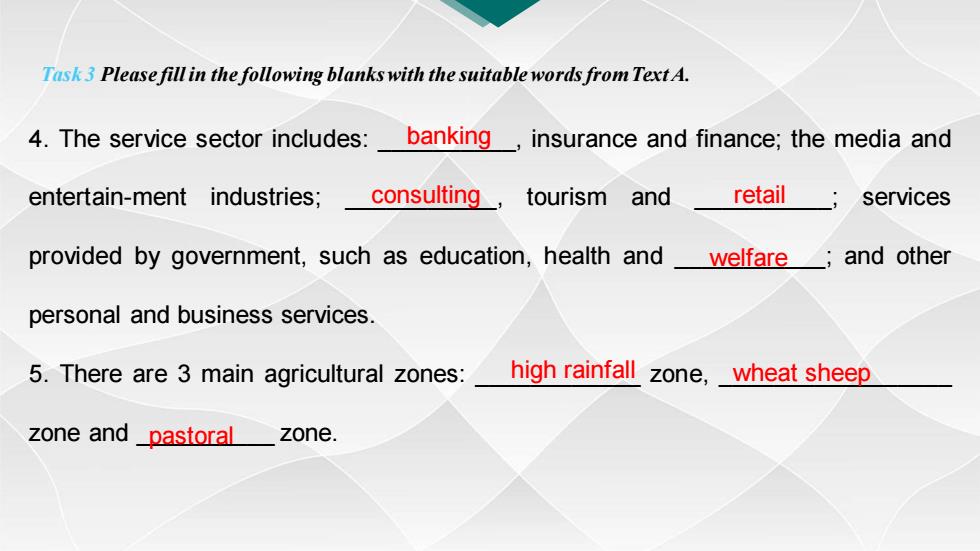
Task 3 Please fill in the following blanks with the suitable words from TextA. 4.The service sector includes:banking,insurance and finance;the media and entertain-ment industries;consulting,tourism and retail services provided by government,such as education,health and welfare;and other personal and business services. 5.There are 3 main agricultural zones: high rainfall zone,wheat sheep zone and pastoralzone
Task 3 Please fill in the following blanks with the suitable words from Text A. 4. The service sector includes: __________, banking insurance and finance; the media and entertain-ment industries; ___________, tourism and __________; services provided by government, such as education, health and ___________; and other personal and business services. 5. There are 3 main agricultural zones: ____________ zone, _________________ zone and __________ zone. consulting retail welfare pastoral high rainfall wheat sheep
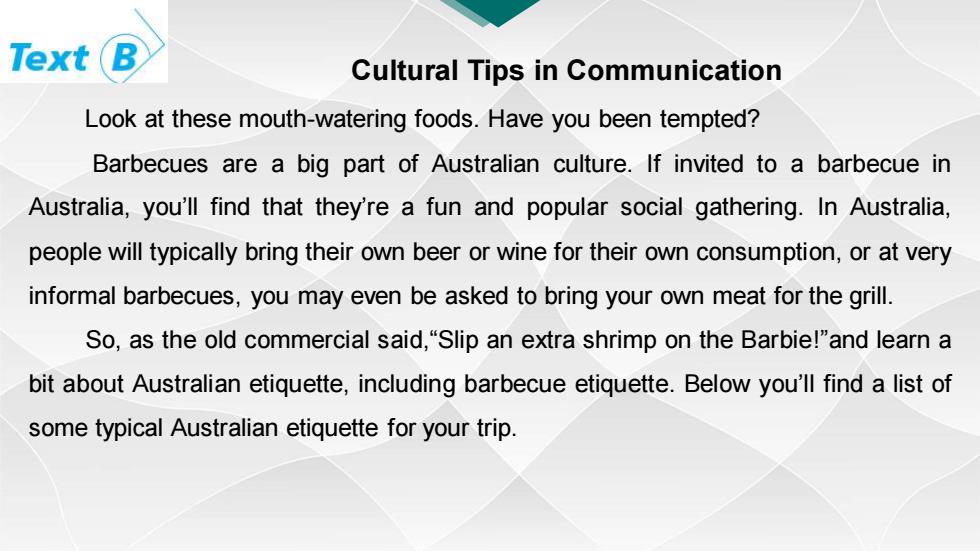
Text Cultural Tips in Communication Look at these mouth-watering foods.Have you been tempted? Barbecues are a big part of Australian culture.If invited to a barbecue in Australia,you'll find that they're a fun and popular social gathering.In Australia, people will typically bring their own beer or wine for their own consumption,or at very informal barbecues,you may even be asked to bring your own meat for the grill. So,as the old commercial said,"Slip an extra shrimp on the Barbie!"and learn a bit about Australian etiquette,including barbecue etiquette.Below you'll find a list of some typical Australian etiquette for your trip
Cultural Tips in Communication Look at these mouth-watering foods. Have you been tempted? Barbecues are a big part of Australian culture. If invited to a barbecue in Australia, you’ll find that they’re a fun and popular social gathering. In Australia, people will typically bring their own beer or wine for their own consumption, or at very informal barbecues, you may even be asked to bring your own meat for the grill. So, as the old commercial said,“Slip an extra shrimp on the Barbie!”and learn a bit about Australian etiquette, including barbecue etiquette. Below you’ll find a list of some typical Australian etiquette for your trip
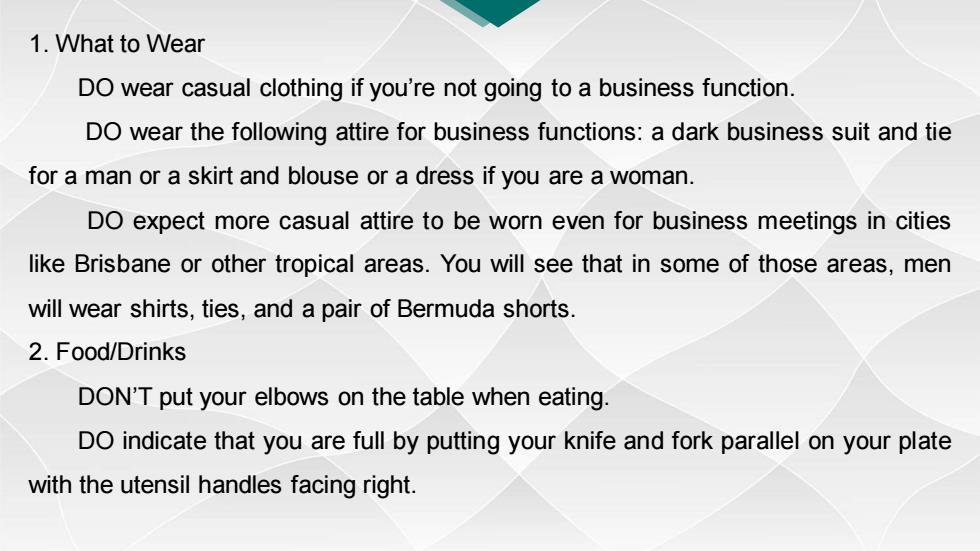
1.What to Wear DO wear casual clothing if you're not going to a business function. DO wear the following attire for business functions:a dark business suit and tie for a man or a skirt and blouse or a dress if you are a woman. DO expect more casual attire to be worn even for business meetings in cities like Brisbane or other tropical areas.You will see that in some of those areas,men will wear shirts,ties,and a pair of Bermuda shorts. 2.Food/Drinks DON'T put your elbows on the table when eating. DO indicate that you are full by putting your knife and fork parallel on your plate with the utensil handles facing right
1. What to Wear DO wear casual clothing if you’re not going to a business function. DO wear the following attire for business functions: a dark business suit and tie for a man or a skirt and blouse or a dress if you are a woman. DO expect more casual attire to be worn even for business meetings in cities like Brisbane or other tropical areas. You will see that in some of those areas, men will wear shirts, ties, and a pair of Bermuda shorts. 2. Food/Drinks DON’T put your elbows on the table when eating. DO indicate that you are full by putting your knife and fork parallel on your plate with the utensil handles facing right
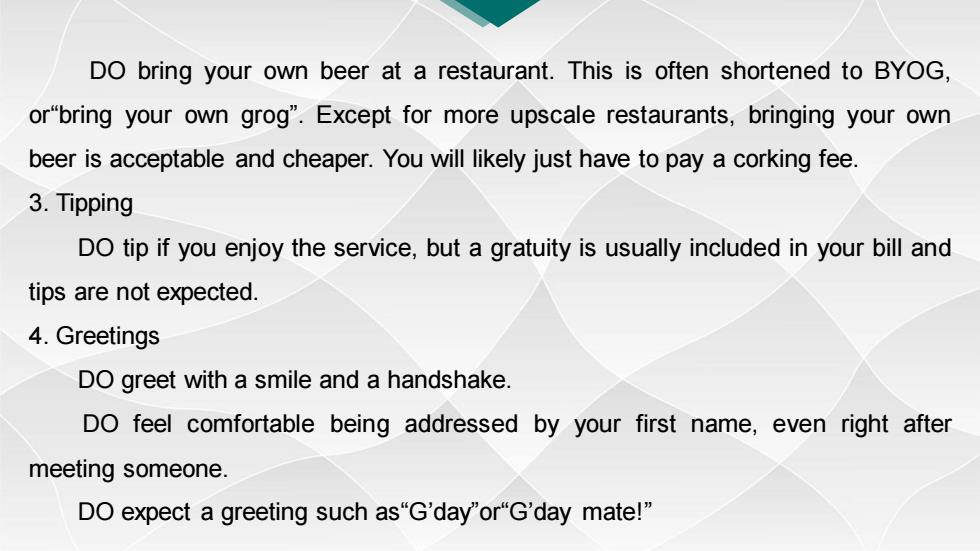
DO bring your own beer at a restaurant.This is often shortened to BYOG, or"bring your own grog".Except for more upscale restaurants,bringing your own beer is acceptable and cheaper.You will likely just have to pay a corking fee. 3.Tipping DO tip if you enjoy the service,but a gratuity is usually included in your bill and tips are not expected. 4.Greetings DO greet with a smile and a handshake. DO feel comfortable being addressed by your first name,even right after meeting someone. DO expect a greeting such as"G'day"or"G'day mate!
DO bring your own beer at a restaurant. This is often shortened to BYOG, or“bring your own grog”. Except for more upscale restaurants, bringing your own beer is acceptable and cheaper. You will likely just have to pay a corking fee. 3. Tipping DO tip if you enjoy the service, but a gratuity is usually included in your bill and tips are not expected. 4. Greetings DO greet with a smile and a handshake. DO feel comfortable being addressed by your first name, even right after meeting someone. DO expect a greeting such as“G’day”or“G’day mate!